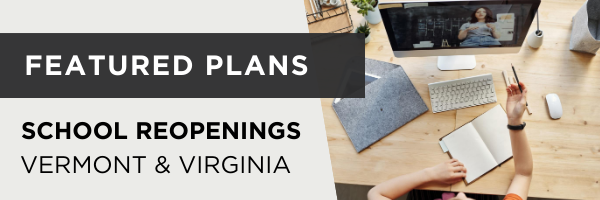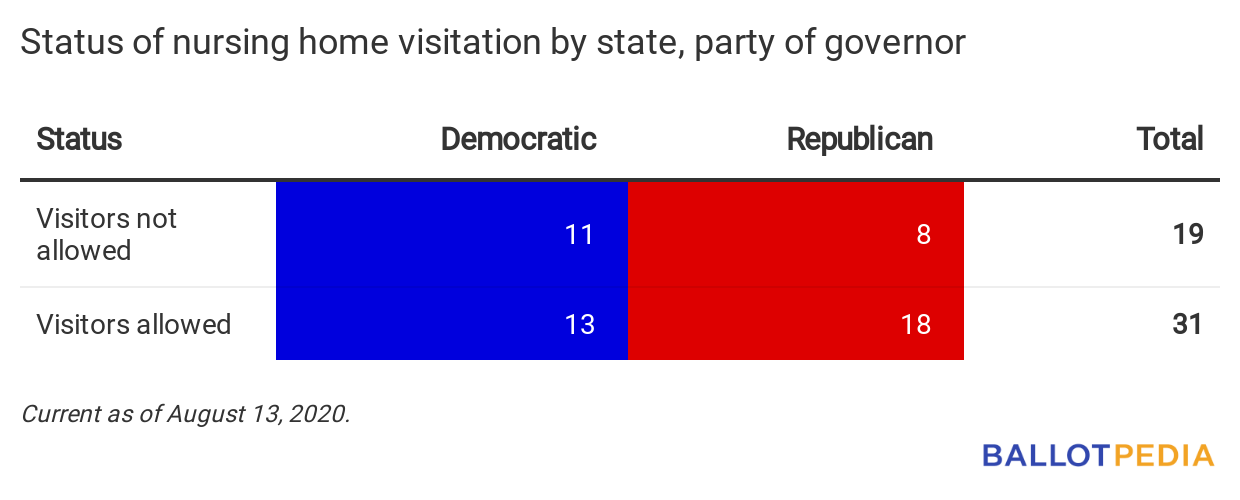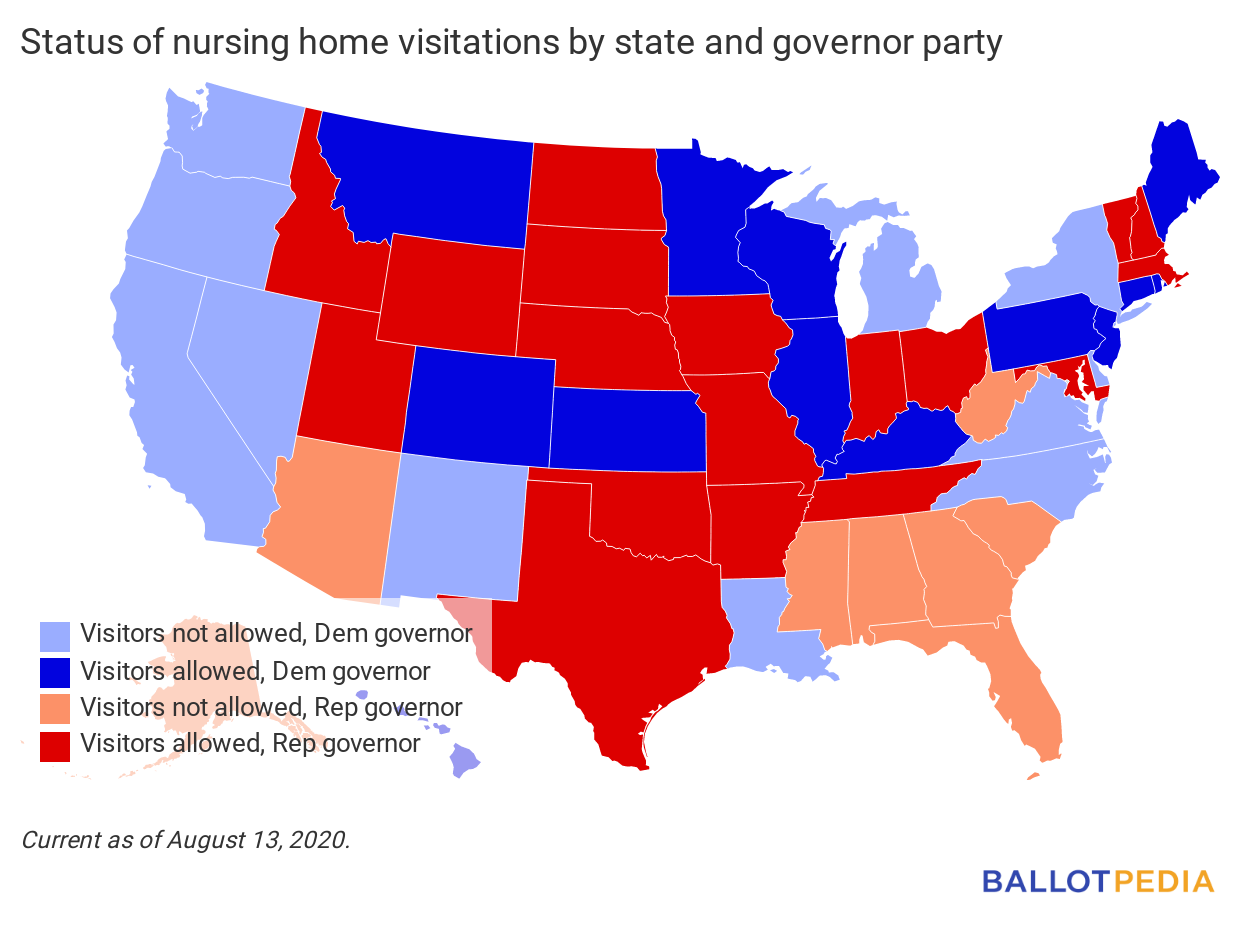Each day, we:
Want to know what happened yesterday? Click here. Since our last editionWhat is open in each state? For a continually updated article on reopening status in all 50 states, click here. For our last edition, click here.
Tracking industries: Nursing home visitsAll 50 states are reopening in some way. Here, we give the status of one industry or activity across the states. Today’s question: in which states may you visit someone in a nursing home? This does not include end-of-life or other emergency-related visits. Visits limited to family members only, or that are only allowed outdoors, are counted as “visitors allowed” in the chart and map below. We last looked at nursing home visitation in the Aug. 6 edition of the newsletter. Since then, Texas began allowing nursing home visitation. Facilities with no confirmed COVID-19 cases in the last 14 days can allow outdoor visitation. West Virginia closed nursing homes to visitors.
|
|||||||||||||||||||||||||||||||||||||||||||||||||||||||||||||||||||||||||||||||||||||||||||||||||||

This is an in-depth summary of two state plans to reopen public K-12 schools for the 2020-2021 school year. Vermont’s A Strong and Healthy StartOn June 17, 2020, the Vermont Agency of Education and the Vermont Department of Health released A Strong and Healthy Start, which provided guidance for safety and public health in school reopening. The state has also provided guidance documents on hybrid learning and decision making for local administrators. Individual school districts must decide if they will open for in-person, hybrid, or remote instruction. Governor Phil Scott said, “At this time, Vermont data continues to support the reopening of schools and we will reassess that at any point,. Parents and our kids deserve the best education that we can possible [sic] provide. … We know a fully remote format creates gaps that some students fall through, and unfortunately this has a greater impact on some students than others.” On July 29, Scott signed an executive order that moved the start of the 2020-2021 academic year to Sept. 8. According to EdWeek, public schools in Vermont traditionally start the academic year in late August, with the exact date varying by district. Scott said the delay would give districts more time to begin with fully remote learning, telling reporters, “It makes sense for some to start with this more conservative approach.” On March 15, Scott ordered all K-12 schools in the state to close on March 18 until at least April 6. On March 26, 2020, Scott announced schools would be closed for the remainder of the academic year. ContextVermont has a divided government. The governor is a Republican, and Democrats hold majorities in both chambers of the state legislature. The state has had a divided government since 2017. The following tables show public education statistics in Vermont, including a rank comparing it to the other 49 states. Rank one is the highest number of each figure, rank 50 is the lowest. All data comes from the Common Core of Data provided by the National Center for Education Statistics.
DetailsDistrict reopening plans On June 4, 2020, the Vermont Agency of Education released guidelines detailing the procedures for reopening. It said individual districts would submit reopening plans that would need to comply with the state-level guidelines outlined in its planning template. In-person, hybrid, and online learning The state’s guidance document allows individual districts to decide whether to use fully in-person schedules, a hybrid model, or fully online learning for the 2020 school year. On July 25, the state released an updated document that stressed school flexibility in planning, saying, “[I]t is important that each district plan for a certain amount of flexibility to shift school instruction along a continuum of options from full in-person instruction to full remote learning, including a hybrid learning approach that might include both.” Mask requirements Students, teachers, and school staff are required to wear facial coverings while in the school building and outside if six feet of social distance cannot be maintained. In-person health recommendations and requirements A Safe and Healthy Start recommends students be kept together in the same groups as much as possible. It also requires the groups to comply with the occupancy standards to ensure they maintain a six-foot social distance. The guidelines recommend installing physical barriers where social distancing is more difficult. Libraries and other communal areas can remain in operation if social distancing is possible and enforced. The plan recommends cafeterias and gyms should not be used for their normal purposes. Rather, they should be used as additional classroom space to help a school to properly allow for social distancing. Before and after school programs are allowed to remain in operation with social distancing requirements and with strict record-keeping suggested. The guidance recommends that anyone showing symptoms of COVID-19 should self-isolate until they have had no fever for 24 hours without the use of medications. Students and staff will be excluded from school activities and buildings if they:
If COVID-19 is confirmed in a student, the school must:
Transportation and busing requirements and restrictions All students and staff must wear facial coverings while on school buses or other transportation. In addition, students should go through a health screening before boarding the bus. The state recommends assigning students to a bus based on their grade cohort and that students are assigned specific seats. ResponsesThe Vermont-NEA, the state’s largest teacher’s union, called for the state to adopt a phased approach rather than let individual districts decide how to reopen. The group has also called for the state to establish a “State Commission comprised of educators, school counselors, school nurses, educational support professionals, custodians and bus drivers, administrators, school board members, parents/caregivers, and AOE representatives” that can evaluate COVID-19 reopening plans. In an open letter to her school district opposing the plan, Harwood Unified Union School District Superintendent Brigid Nease said:
Vermont Secretary of Education Dan French said the decision offers individual districts options rather than dictates policy for the entire state. On Aug. 10, he told VTDigger:
Virginia’s Recover, Redesign, RestartThe Virginia Department of Education most recently updated its school reopening guidance on July 6. When the guidance was first introduced in June, Gov. Ralph Northam (D) said, “Resuming in-person instruction is a high priority, but we must do so in a safe, responsible, and equitable manner that minimizes the risk of exposure to the virus and meets the needs of the Virginia students who have been disproportionately impacted by lost classroom time.” Secretary of Education Atif Qarni said a phased opening of schools was designed with social and emotional wellbeing in mind. Qarni said, “These plans are informed by a range of perspectives and will help ensure that we prioritize the social emotional well-being of all of our students, their families, and educators as we go back to school this summer and fall.” Virginia does not have a statewide date for public schools to reopen. Each district will decide when and with what form of instruction to reopen schools. According to EdWeek, public schools in Virginia start the academic year no earlier than 14 days before Labor Day. On March 14, Northam ordered all K-12 schools in the state to close for at least two weeks, effective March 16. On March 23, he announced that all schools would be closed for the rest of the school year. ContextVirginia is a Democratic trifecta. The governor is a Democrat, and Democrats have majorities in both chambers of the state legislature. The state became a Democratic trifecta in 2020. The following tables show public education statistics in Virginia, including a rank comparing it to the other 49 states. Rank one is the highest number of each figure, rank 50 is the lowest. All data comes from the Common Core of Data provided by the National Center for Education Statistics.
DetailsDistrict reopening plans On June 6, Northam introduced a phased guide to reopening public schools in Virginia. Phase One uses distance learning as the mode of education, with limited access to school facilities for students with disabilities. Phase Two allows for limited in-person instruction, especially for grades K-3. Phase Three allows for in-person instruction with social distancing and health and safety precautions taken. When he announced the phased plan, Northam said that most schools could reopen in Phase Two. The Recover, Redesign, Restart plan was revised on July 8 to include further instructions for Phase Three of reopening. In the revision, the state recommends practices and procedures for reopening schools but leaves the specific plans for reopening to individual school districts. According to the Virginia Department of Education, at least 15 days before instruction begins, “Public school divisions are required to submit a plan for providing new instruction to all students in the 2020-2021 academic year, regardless of phase or the operational status of the school at the time. This plan must also include strategies to address learning lost due to spring 2020 school closures. This should include a plan for fully remote instruction should public health conditions require it.” Districts are also recommended to post their plans on their websites for public viewing. In-person, hybrid, and online learning According to state guidance, schools will offer a variety of learning models depending on the plans they submit to the state. All districts must include plans for fully remote learning, but the phased model of reopening requires schools to plan for some level of in-person instruction. The guidance document states, “While the broad parameters of each phase are defined by the state, a great deal of local autonomy exists and school divisions have the flexibility to respond to this guidance within the capacity and resources of the division.” The state says alternative schedules may be necessary to maintain physical distance and outlines multiple possibilities in its guidelines. The guidelines state, “In order to adhere to the physical distancing requirements, schools will need to consider alternative and innovative schedules for their school buildings. These schedules will need to consider the developmental abilities and academic needs of the students served in each scenario, while maximizing physical distancing of students.” Mask requirements During all phases of Virginia’s plan, face coverings are recommended when six-foot physical is not possible. Face coverings are not required in any phase. In-person health recommendations and requirements Social distancing is required in all phases of the state reopening plan. In Phase Three, the most advanced phase of the plan, all individuals are required to be at least three feet apart. Each phase also accounts for increased occupancy of spaces like auditoriums, playgrounds, and cafeterias. Phase One allows 10 people in a space, Phase Two allows 50, and Phase Three allows 250. All phases require that space allows for six feet of distance. The state guidelines recommend daily health screenings for all students, faculty, and staff, and that any person who does not pass the health screening stay home. Those experiencing symptoms of COVID-19 are encouraged to isolate, and those who experience symptoms in school are required to isolate. According to the Virginia Department of Education:
Transportation and busing requirements and restrictions During Phase One, bus capacity is limited to 10 students per bus. During later phases, bus capacity is recommended to be at an amount that allows for appropriate physical distancing. Face coverings are recommended but not required. ResponsesAccording to Richmond Magazine, the organization Virginia Educators United launched a petition in July, suggesting the state “keep classrooms closed until infections trend downward for at least 24 days and until preventive measures such as proper classroom ventilation, cleaning supplies and personal protective equipment are fully funded by the state.” Former Virginia Gov. Douglas Wilder (D), now a professor of public policy at Virginia Commonwealth University, told the Virginia Mercury he disagreed with Northam’s decision to allow individual districts to determine their reopening plans, saying, “I would not have done it that way. There need to be comprehensive, almost uniform requirements across the state. The plan cannot be helter-skelter.” Additional activityIn this section, we feature examples of other federal, state, and local government activity, as well as influencers relevant to recovering from the pandemic.
|
|||||||||||||||||||||||||||||||||||||||||||||||||||||||||||||||||||||||||||||||||||||||||||||||||||
Documenting America’s Path to Recovery: August 13, 2020
By



